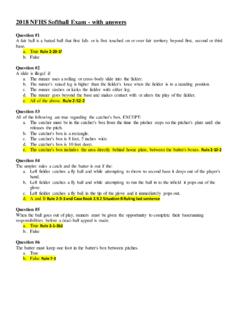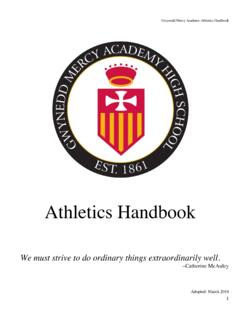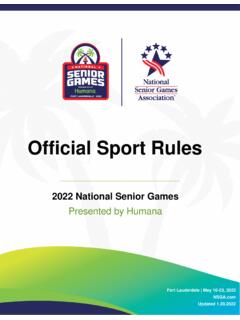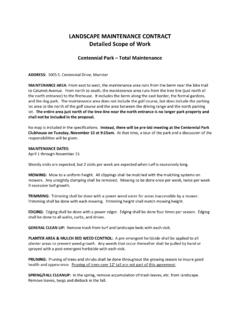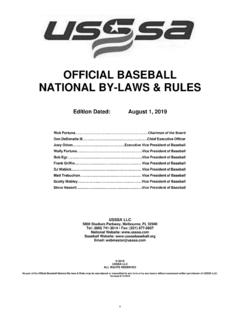Transcription of Anterior Cruciate Ligament (ACL) and Meniscus Repair ...
1 Anterior Cruciate Ligament (ACL) and Meniscus Repair Rehabilitation Protocol General notes: As tolerated should be understood to include with safety for the reconstruction/ Repair ; pain, limp, swelling, or other undesirable factors are indicators that you are doing too much too soon. If any of these should occur, decrease activity level, ice and elevate the leg. Ice should be applied to the knee for 15 to 20 minutes following each exercise, therapy, or training session. While your knee remains swollen icing should also be done separate from exercise at least three times per day. Return to sport is based on provider team (physician, physician assistant, athletic trainer, therapist) input and appropriate testing. All times and exercises are to serve as guidelines. Progression through the protocol should be based upon criteria as opposed to dates listed and will vary depending on each individual patient.
2 Progress should be agreed upon by the patient and his/her team of providers. Pre-Operative Care Brace: Use as directed prior to surgery Weight Bearing: Full, crutches as necessary ROM (range of motion) Goals: Extension (straighten knee): Full Flexion (bend knee): 135 degrees Therapeutic Exercise: Calf Stretching, Quad sets, four-way straight leg raises (SLR), Heel slides, prop knee extension. Learn exercises for post op regimen. Modalities: Cryotherapy (Ice) six to eight times per for 15 to 20 minutes each time, dependant on swelling Goal: Minimal to no swelling Full ROM Normal strength Anterior Cruciate Ligament (ACL) and Meniscus Repair Rehabilitation Protocol Post-Operative Phase 1: (Weeks 1 - 4) Brace: Use as directed before surgery Crutches/Function: Bilateral (2) axillary crutches Ambulation TTWB (toe-touch weight bearing) with crutches Begin progression to full weight bearing if directed to do so by surgeon ROM: 0 to 90 degrees Active and passive Therapeutic Exercise.
3 Quad sets, isometric knee extension at multiple angles in allowed range of motion and as tolerated at patellofemoral (PF) joint, open kinetic chain (OKC) knee extension 90 to 0 as tolerated at PF joint Isometric and OKC hamstring strengthening in pain free ROM Hip 4-way SLR (straight leg raise) Ankle and foot stretching and strengthening in non-weight bearing No exercises in weight bearing Manual: Scar and soft tissue massage, patella mobilizations Proprioception: Seated BAPS board Cardio: UBE (arm bike) Modalities: NMES (neuromuscular electrical stimulation) for quadriceps atrophy, strengthening as needed HVPC (high volt pulsed current) for effusion (swelling) reduction as needed Cryotherapy six to eight times per day for 15 to 20 minutes each Progression to Phase II: Anterior Cruciate Ligament (ACL) and Meniscus Repair Rehabilitation Protocol Hip flexion SLR without knee extension lag Full knee extension Knee flexion to 90 Minimal joint effusion Ambulation without assistive device or limp Post-Operative Phase II: (Weeks 4 8) Brace: Use as directed before surgery until week 6 Crutches/Function: Bilateral (2) axillary crutches Ambulation PWB (partial weight bearing) with crutches Begin progression to full weight bearing if directed to do so by surgeon ROM: 0 to 120 - Active and passive Therapeutic Exercises: Closed chain strengthening in pain free ROM (no >90 ), OKC knee extension and flexion as tolerated Total leg strengthening Core strengthening Manual: Scar and soft tissue massage, patella mobilizations Proprioception: SLS (single limb stance), BAPS, unstable surfaces Joint repositioning Cardio.
4 UBE, stationary bike, elliptical Modalities: NMES for quadriceps atrophy, strengthening as needed Anterior Cruciate Ligament (ACL) and Meniscus Repair Rehabilitation Protocol HVPC for effusion reduction as needed Cryotherapy: Six to eight times per day for 15 to 20 minutes each Progression to Phase III: Knee ROM 0 -120 No effusion No pain Good eccentric control of involved knee Isometric quad strength 70% of non-involved side at 60 knee flexion Isometric hamstring strength 70% of non-involved side at 60 knee flexion Isokinetic quad strength 70% of non-involved side tested at 300 /sec Isometric hamstring/quad ratio >60% tested at 60 knee flexion Post Operative Phase III: (Weeks 8 - 12) Note: *Do not initiate new activities during post-op week eight due to graft vulnerability* Therapeutic Exercises: Progress ROM and flexibility to full if limited, CKC multi-plane activities within pain-free ROM, OKC knee extension 90 to 40 with 1# weight increase per week Hip and core strengthening Proprioception: SLS, BAPS, unstable surfaces Joint repositioning Perturbation training (balance against resistance) Cardio: UBE, stationary bike, treadmill ambulation Plyometrics: Do not initiate double leg plyometrics, jumping, or running until cleared by surgeon and 3 month functional test at Elite is completed Modalities: Cryotherapy after activity for 15 to 20 minutes Anterior Cruciate Ligament (ACL) and Meniscus Repair Rehabilitation Protocol Progression to Phase IV: Full ROM No effusion No pain Proprioception 80 to 100% of non-involved side Isometric quad strength 80% of non-involved side Hamstring to quad ratio 70% Minimum of 10 weeks post-op Post Operative Phase IV.
5 (Weeks 12 16) Therapeutic Exercises: Progress ROM and flexibility to full if limited, initiate running program in straight plane, CKC multi-plane activities within pain-free ROM, OKC knee extension 90 to 40 with 1# weight increase per week Proprioception: SLS, BAPS, unstable surfaces Joint repositioning Perturbation training Cardio: UBE, stationary bike, progress to treadmill running Plyometrics: May be initiated if cleared by surgeon to do so after completing 3 month functional test at Elite. If cleared by surgeon, initiate sagittal plane double leg landing drills, double leg plyometrics, and walk/ jog interval progression as tolerated. Progress to multi-plane plyometrics after 16 weeks. Progression to Phase V: Isokinetic hamstring strength 110% of non-involved side Proprioception 100% Post Operative Phase V: (Weeks 16 24) Recommend pursuing Transitional Therapy for return to sport activities during this phase Anterior Cruciate Ligament (ACL) and Meniscus Repair Rehabilitation Protocol Transitional Therapy a strength and conditioning program that is lead by medical professionals with a sports medicine background with the goal of transitioning from therapy back to sport Contact Elite Sports Medicine for details In addition to ongoing strength, balance, agility, and cardio conditioning, initiate sport specific plyometric activities as tolerated such as: Soccer/Football.
6 Two foot ankle hop, double-leg hop, front barrier hop, lateral barrier hop, single-leg hop, power skip, backward skip, double arm alternate leg bound, and cycled split squat jump Basketball/Volleyball: Two foot ankle hop, double-leg hop, squat jump, double-leg vertical jump, single-leg hop, single-leg vertical jump, power skip, backwards skip, double-arm alternate-leg bound, alternate leg push off box drill, and side-to-side push off box drill Baseball/ softball /Overhead throwing sports: Two foot ankle hops, double-leg hop, front barrier hop, lateral barrier hop, single-leg hop, power skip, backward skip, double arm alternate leg bound, cycled split squat jump, and return to throwing program Return to Sport: Referral point at 16 weeks for four to eight week program to address functional/return to sport deficits Six month follow up testing: KT 2000 Test to assess tibial translation Isokinetic testing to assess strength of hamstring/quadriceps Jump and hop testing
